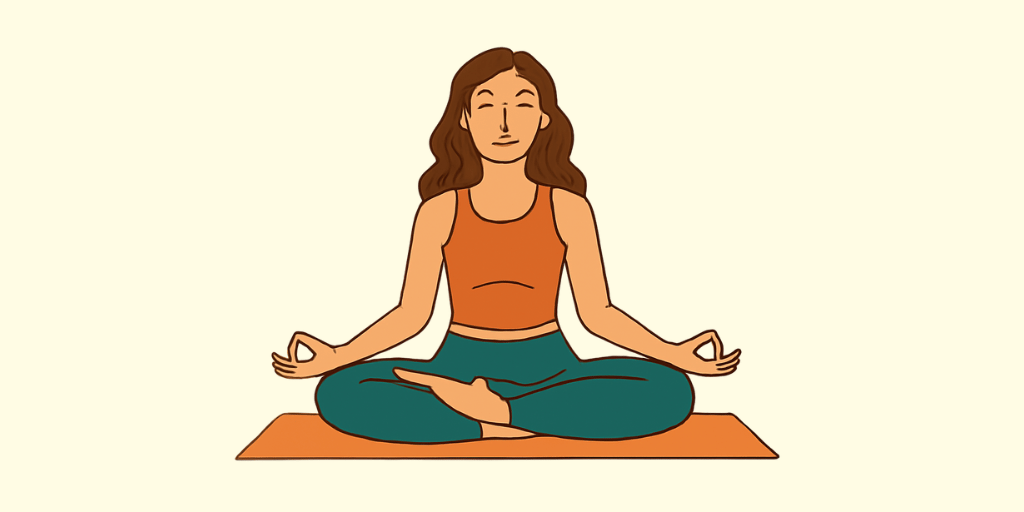Sanskrit Name: पद्मासन
English Name: Lotus Pose
Description:
Padmasana, commonly known as the Lotus Pose, is more than just a basic stretch; it serves as a pathway to a deeper connection between your mind, body, and spirit. This ancient yoga position has been practiced for centuries and, with consistent practice, offers numerous benefits that extend beyond the physical realm. It aids in calming the mind, grounding your energy, and fostering inner peace, making it an effective tool for those seeking balance and clarity in life. It’s not merely about remaining still; it’s about cultivating harmony within yourself.
By incorporating it into your yoga routine, you will likely notice enhancements in both your physical and mental well-being. Remember that everyone’s journey toward improved health and inner peace is unique, and your experience with Padmasana will be distinctly yours.
How to Do It:
Here are the steps to do Padmasana (Lotus Pose):
-
Sit on the Floor: Begin by sitting on the floor with your legs extended straight in front of you and your spine upright.
-
Bend Your Right Leg: Gently bend your right knee and bring your right foot towards your left thigh. Place the sole of your right foot on the inner side of your left thigh, close to the hip.
-
Bend Your Left Leg: Bend your left knee and bring your left foot over your right thigh. Place the sole of your left foot on the inner side of your right thigh, close to the hip.
-
Position Your Feet: Your feet should be placed so that the soles are facing upward and the heels are close to the abdomen. Both feet should be resting on the opposite thighs.
-
Align Your Spine: Sit up straight with your spine elongated. Imagine a string pulling the top of your head towards the ceiling to maintain a long, tall posture.
-
Place Your Hands: Rest your hands on your knees in a mudra of your choice (e.g., Gyan Mudra – tip of the index finger touching the tip of the thumb). Palms can face upward or downward.
-
Relax Your Shoulders: Relax your shoulders away from your ears and let your arms remain relaxed.
-
Focus on Your Breath: Close your eyes and focus on your breathing. Take deep, steady breaths in and out through your nose.
-
Hold the Pose: Hold the position for 5 to 15 minutes, focusing on maintaining a calm and steady breath. If you’re new to this pose, start with shorter durations and gradually increase over time.
-
Release the Pose: To release, gently uncross your legs, stretch them out in front of you, and shake them gently to relieve any tension.
Padmasana may take time to master, especially if you’re not used to sitting with your legs crossed in this way.
Benefits:
Padmasana, or Lotus Pose, offers numerous therapeutic benefits, including:
- Improved Flexibility: Regular practice enhances flexibility in the hips, knees, and ankles, making it easier to sit for extended periods.
- Enhanced Circulation: The seated position promotes better blood flow to the lower body, which can alleviate numbness and improve overall circulation.
- Calmness and Focus: Padmasana encourages a meditative state, helping reduce stress and anxiety while improving concentration and mental clarity.
- Spinal Alignment: The pose promotes proper spinal alignment, which can relieve tension in the back and improve posture.
- Digestive Benefits: Sitting in this position can stimulate the digestive organs, aiding in digestion and alleviating discomfort.
- Emotional Stability: It helps balance emotions and fosters a sense of inner peace, contributing to emotional well-being.
Medical Conditions(Relief):
These benefits make Padmasana a valuable addition to yoga practice, particularly for those seeking mental and physical balance. Padmasana, or Lotus Pose, is beneficial for various medical conditions, including:
- Anxiety and Stress: This posture promotes relaxation and helps in reducing anxiety levels by calming the mind and improving focus.
- Digestive Issues: Practicing Padmasana can enhance digestion and alleviate symptoms of constipation by stimulating the abdominal organs.
- Sciatica: It can provide relief from sciatica pain by stretching the hips and improving flexibility in the lower back.
- Knee Problems: Regular practice may strengthen the knee joints and improve stability, aiding those with knee discomfort.
- Reproductive Health: Padmasana is believed to enhance blood circulation in the pelvic region, which can support reproductive health.
These benefits make Padmasana a valuable addition to yoga practices for individuals dealing with these conditions.
Medical Conditions(Avoid):
Padmasana or Lotus Pose, should be avoided in the following medical conditions:
- Knee Injuries: Individuals with current or past knee injuries may experience pain or further damage when attempting this posture.
- Hip Disorders: Those with hip pain or conditions such as arthritis may find Padmasana uncomfortable or harmful.
- Sciatica: This condition can be aggravated by the pressure and positioning required in Padmasana.
- Ankle Injuries: Ankle sprains or chronic pain can be exacerbated by the strain of this pose.
- Pregnancy: Pregnant individuals should avoid this asana, especially in later trimesters, due to the pressure on the abdomen.
- Recent Surgeries: Anyone recovering from surgery, particularly in the lower body, should refrain from practicing Padmasana until fully healed.
- Severe Back Pain: Those with chronic or acute back issues may find this pose uncomfortable and should avoid it.

